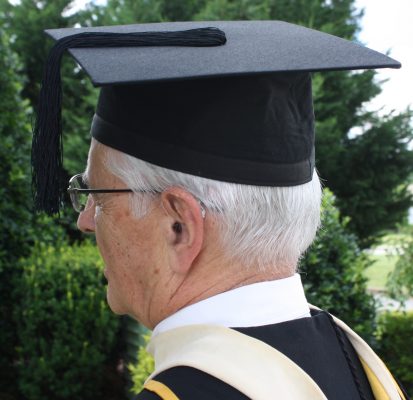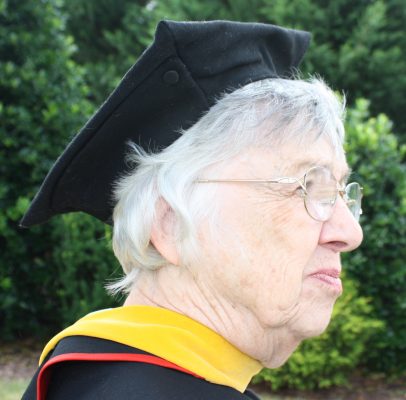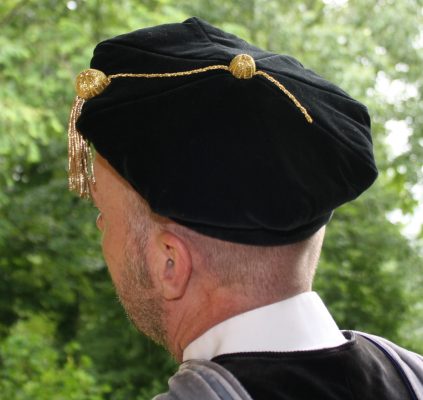Information About Academic Caps
Today’s mortarboard is an amalgamation of several types of ecclesiastical and secular caps from the Middle Ages, having achieved its current form in the 1700’s. Previously it had sported a pompom instead of a tassel. The tam, often used in the United States by professors with a Doctor’s degree, appears to have been derived from British lay fashion during the 16th century, as was the Tudor Bonnet (or Beefeater Cap) which is worn in Commonwealth countries today but is less commonly seen in America.
The 1895 Intercollegiate Code of Academic Costume dictated one type of cap. The traditional mortarboard would be used by bachelors, masters, and doctors. It would be sewn from the same black “worsted stuff” cloth used for the gown, black serge cloth, or black broadcloth fabric and would have a black tassel on top. Doctors, however, were allowed to wear a mortarboard made from black velvet fabric with a fancy gold tassel.
Early tassels were nothing more than a cluster of thick fabric threads fastened by a button on the top center of the mortarboard, but within a few years a long braided cord would begin to be used to hold a woven tassel that draped over the edge of the mortarboard (and if the tassel was too long, into the eyes of the wearer).
By 1909 the tradition of moving the tassel from the right to the left side of the mortarboard had been established, probably as a feeble substitute for the individual hooding of bachelors. Doctoral mortarboards were purchased with the golden tassel already sewn to the left side.


Bachelor’s hoods were never commonly worn, and the graduate’s degree title cannot be discerned from the gown design alone. So to communicate this information today, many colleges and universities use undergraduate mortarboard tassels in the Faculty color of the wearer, contra the Intercollegiate Code which only permits black tassels for bachelors. Thus a mortarboard with a white tassel would indicate a student with a Bachelor of Arts degree, a golden yellow tassel would signify a Bachelor of Science degree, a pink tassel would indicate a Bachelor of Music degree, and so on. Wearing a colored tassel with one’s master’s or doctor’s cap is considered gauche.
Mortarboards are also known as “square academic caps”, “squares”, “Oxford caps”, or “trenchers”. Early mortarboards had a stiff crown that allowed the cap to sit more comfortably on the top of one’s head. By the early 1900s mortarboards could be purchased with a soft crown that could be folded for easier storage, but these caps tended to slip off the side of the wearer’s head. To solve this problem, today some
manufacturers sell mortarboards with soft crowns with an elasticated edge. These caps should be avoided, as they resemble a black shower cap with a rigid square fastened to the top.
By the 1930s, female faculty members would sometimes wear a black-colored soft cap similar to the Oxford soft cap for women. Apparently derived from a style of cap worn by Erasmus and other scholars during the Renaissance, this cap was square, like the mortarboard, but did not have the stiff board inside nor a tassel. Under the square, the sides of the cap – traditionally used as ear warmers – were folded up and fastened with two buttons.
Not to be outdone, male faculty members began to wear a soft cap, or “tam”. This cap was sewn from black velvet fabric and had either four, six, or eight sides with a gold tassel on top. Originally the tam was considered to be a cap for doctoral faculty only, but today some manufacturers are creating what they call “master’s tams” with


standard black tassels. This is an unfortunate development that should not be encouraged.
As an interesting footnote, it should be pointed out that the mortarboard is historically derived from the pileus quadratus, a type of round Roman skullcap called the pileus rotundus with a square-shaped piece of folded fabric sewn to the top. In the early Christian Church the pileus quadratus evolved into the biretta, and since the faculty of most European universities were members of the clergy, variations of the biretta, including the mortarboard, became associated with collegiate faculty. What this means is that – traditionally-speaking – theological faculty should wear the mortarboard and not the tam, as the tam is a “secular” type of academic cap.